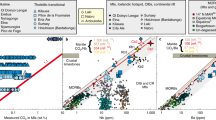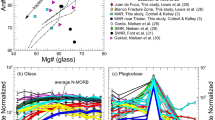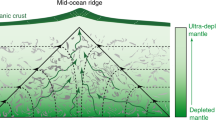Abstract
The onset of melting in the Earth’s upper mantle influences the thermal evolution of the planet, fluxes of key volatiles to the exosphere, and geochemical and geophysical properties of the mantle. Although carbonatitic melt could be stable 250 km or less beneath mid-oceanic ridges1,2, owing to the small fraction (∼0.03 wt%) its effects on the mantle properties are unclear. Geophysical measurements, however, suggest that melts of greater volume may be present at ∼200 km (refs 3–5) but large melt fractions are thought to be restricted to shallower depths. Here we present experiments on carbonated peridotites over 2–5 GPa that constrain the location and the slope of the onset of silicate melting in the mantle. We find that the pressure–temperature slope of carbonated silicate melting is steeper than the solidus of volatile-free peridotite and that silicate melting of dry peridotite + CO2 beneath ridges commences at ∼180 km. Accounting for the effect of 50–200 p.p.m. H2O on freezing point depression, the onset of silicate melting for a sub-ridge mantle with ∼100 p.p.m. CO2 becomes as deep as ∼220–300 km. We suggest that, on a global scale, carbonated silicate melt generation at a redox front ∼250–200 km deep6, with destabilization of metal and majorite in the upwelling mantle, explains the oceanic low-velocity zone and the electrical conductivity structure of the mantle. In locally oxidized domains, deeper carbonated silicate melt may contribute to the seismic X-discontinuity. Furthermore, our results, along with the electrical conductivity of molten carbonated peridotite7 and that of the oceanic upper mantle5, suggest that mantle at depth is CO2-rich but H2O-poor. Finally, carbonated silicate melts restrict the stability of carbonatite in the Earth’s deep upper mantle, and the inventory of carbon, H2O and other highly incompatible elements at ridges becomes controlled by the flux of the former.
This is a preview of subscription content, access via your institution
Access options
Subscribe to this journal
Receive 51 print issues and online access
$199.00 per year
only $3.90 per issue
Buy this article
- Purchase on Springer Link
- Instant access to full article PDF
Prices may be subject to local taxes which are calculated during checkout


 .
.

Similar content being viewed by others
References
Rohrbach, A. & Schmidt, M. W. Redox freezing and melting in the Earth’s deep mantle resulting from carbon–iron redox coupling. Nature 472, 209–212 (2011)
Dasgupta, R. & Hirschmann, M. M. Melting in the Earth’s deep upper mantle caused by carbon dioxide. Nature 440, 659–662 (2006)
Dalton, C. A., Ekström, G. & Dziewonski, A. M. The global attenuation structure of the upper mantle. J. Geophys. Res. 113, B09303 (2008)
Hammond, W. C. & Toomey, D. R. Seismic velocity anisotropy and heterogeneity beneath the Mantle Electromagnetic and Tomography Experiment (MELT) region of the East Pacific Rise from analysis of P and S body waves. J. Geophys. Res. 108, 2176 (2003)
Lizarralde, D., Chave, A., Hirth, G. & Schultz, A. Northeastern Pacific mantle conductivity profile from long-period magnetotelluric sounding using Hawaii-to-California submarine cable data. J. Geophys. Res. 100, 17837–17854 (1995)
Rohrbach, A. et al. Metal saturation in the upper mantle. Nature 449, 456–458 (2007)
Yoshino, T., McIsaac, E., Laumonier, M. & Katsura, T. Electrical conductivity of partial molten carbonate peridotite. Phys. Earth Planet. Inter. 194–195, 1–9 (2012)
Langmuir, C. H., Klein, E. M. & Plank, T. in Mantle Flow and Melt Generation at Mid-ocean Ridges (eds Phipps Morgan, J., Blackman, D. K. & Sinton, J. M. ) 183–280 (American Geophysical Union Monograph no. 71, 1992)
O’Leary, J. A., Gaetani, G. A. & Hauri, E. H. The effect of tetrahedral Al3+ on the partitioning of water between clinopyroxene and silicate melt. Earth Planet. Sci. Lett. 297, 111–120 (2010)
Stixrude, L. & Lithgow-Bertelloni, C. Influence of phase transformations on lateral heterogeneity and dynamics in Earth’s mantle. Earth Planet. Sci. Lett. 263, 45–55 (2007)
Karato, S.-i. in Inside the Subduction Factory (ed. Eiler, J.) 135–152 (American Geophysical Union Monograph no. 138, 2003)
Baba, K., Chave, A. D., Evans, R. L., Hirth, G. & Mackie, R. L. Mantle dynamics beneath the East Pacific Rise at 17°S: insights from the Mantle Electromagnetic and Tomography (MELT) experiment. J. Geophys. Res. 111 (B2). B02101 (2006)
Gudfinnsson, G. & Presnall, D. C. Continuous gradations among primary carbonatitic, kimberlitic, melilititic, basaltic, picritic, and komatiitic melts in equilibrium with garnet lherzolite at 3–8 GPa. J. Petrol. 46, 1645–1659 (2005)
Stagno, V. & Frost, D. J. Carbon speciation in the asthenosphere: Experimental measurements of the redox conditions at which carbonate-bearing melts coexist with graphite or diamond in peridotite assemblages. Earth Planet. Sci. Lett. 300, 72–84 (2010)
Dasgupta, R., Hirschmann, M. M. & Smith, N. D. Water follows carbon: CO2 incites deep silicate melting and dehydration beneath mid-ocean ridges. Geology 35, 135–138 (2007)
Hirschmann, M. M. Mantle solidus: experimental constraints and the effects of peridotite composition. Geochem. Geophys. Geosyst. 1, 1042 (2000)
Foley, S. F. et al. The composition of near-solidus melts of peridotite in the presence of CO2 and H2O between 40 and 60 kbar. Lithos 112 (Supplement 1). 274–283 (2009)
Cartigny, P., Pineau, F., Aubaud, C. & Javoy, M. Towards a consistent mantle carbon flux estimate: Insights from volatile systematics (H2O/Ce, δD, CO2/Nb) in the North Atlantic mantle (14° N and 34° N). Earth Planet. Sci. Lett. 265, 672–685 (2008)
Marty, B. & Tolstikhin, I. N. CO2 fluxes from mid-ocean ridges, arcs and plumes. Chem. Geol. 145, 233–248 (1998)
Saal, A. E., Hauri, E., Langmuir, C. H. & Perfit, M. R. Vapour undersaturation in primitive mid-ocean-ridge basalt and the volatile content of Earth’s upper mantle. Nature 419, 451–455 (2002)
Michael, P. J. The concentration, behavior and storage of H2O in the suboceanic upper mantle: implications for mantle metasomatism. Geochim. Cosmochim. Acta 52, 555–566 (1988)
Hirschmann, M. M. Partial melt in the oceanic low velocity zone. Phys. Earth Planet. Inter. 179, 60–71 (2010)
Aubaud, C., Pineau, F., Hekinian, R. & Javoy, M. Degassing of CO2 and H2O in submarine lavas from the Society hotspot. Earth Planet. Sci. Lett. 235, 511–527 (2005)
Sobolev, A. V. & Chaussidon, M. H2O concentrations in primary melts from supra-subduction zones and mid-ocean ridges: implications for H2O storage and recycling in the mantle. Earth Planet. Sci. Lett. 137, 45–55 (1996)
Dasgupta, R. & Hirschmann, M. M. The deep carbon cycle and melting in Earth’s interior. Earth Planet. Sci. Lett. 298, 1–13 (2010)
Baba, K. et al. Electrical conductivity imaging of the Philippine Sea upper mantle using seafloor magnetotelluric data. Phys. Earth Planet. Inter. 183, 44–62 (2010)
Gaillard, F., Malki, M., Iacono-Marziano, G., Pichavant, M. & Scaillet, B. Carbonatite melts and electrical conductivity in the asthenosphere. Science 322, 1363–1365 (2008)
Bagley, B. & Revenaugh, J. Upper mantle seismic shear discontinuities of the Pacific. J. Geophys. Res. 113 (B12). B12301 (2008)
Yoshino, T., Yamazaki, D. & Mibe, K. Well-wetted olivine grain boundaries in partially molten peridotite in the asthenosphere. Earth Planet. Sci. Lett. 283, 167–173 (2009)
Bercovici, D. & Karato, S.-i. Whole-mantle convection and the transition-zone water filter. Nature 425, 39–44 (2003)
Yasuda, A., Fujii, T. & Kurita, K. Melting phase relations of anhydrous mid-ocean ridge basalt from 3 to 20 GPa: implications for the behavior of subducted oceanic crust in the mantle. J. Geophys. Res. 99, 9401–9414 (1994)
Dasgupta, R. & Hirschmann, M. M. Effect of variable carbonate concentration on the solidus of mantle peridotite. Am. Mineral. 92, 370–379 (2007)
Tsuno, K. & Dasgupta, R. Melting phase relation of nominally anhydrous, carbonated pelitic-eclogite at 2.5–3.0 GPa and deep cycling of sedimentary carbon. Contrib. Mineral. Petrol. 161, 743–763 (2011)
Dasgupta, R., Hirschmann, M. M. & Withers, A. C. Deep global cycling of carbon constrained by the solidus of anhydrous, carbonated eclogite under upper mantle conditions. Earth Planet. Sci. Lett. 227, 73–85 (2004)
Acknowledgements
We thank C. Ballhaus for reviewing the manuscript. This study received support from the National Science Foundation and a Packard fellowship to R.D.
Author information
Authors and Affiliations
Contributions
R.D. designed the project, performed most of the experiments and sample analyses, and wrote the paper. A.M. conducted the experiments and analyses of carbonated silicate melt fluxed peridotite compositions. K.T. participated in conducting the piston cylinder experiments and analyses of peridotite + CO2 bulk compositions. A.C.W. participated in the multi-anvil experiments. All authors, including G.H. and M.M.H., participated in the discussion and commented on the paper.
Corresponding author
Ethics declarations
Competing interests
The authors declare no competing financial interests.
Supplementary information
Supplementary Information
This file contains a Supplementary Discussion, Supplementary Figures 1-4, Supplementary Tables 1-3 and Supplementary References. (PDF 492 kb)
Rights and permissions
About this article
Cite this article
Dasgupta, R., Mallik, A., Tsuno, K. et al. Carbon-dioxide-rich silicate melt in the Earth’s upper mantle. Nature 493, 211–215 (2013). https://doi.org/10.1038/nature11731
Received:
Accepted:
Published:
Issue Date:
DOI: https://doi.org/10.1038/nature11731
This article is cited by
-
Asthenospheric low-velocity zone consistent with globally prevalent partial melting
Nature Geoscience (2023)
-
Recycled carbonates elevate the electrical conductivity of deeply subducting eclogite in the Earth’s interior
Communications Earth & Environment (2023)
-
Genesis and evolution of kimberlites
Nature Reviews Earth & Environment (2023)
-
A plume origin for hydrous melt at the lithosphere–asthenosphere boundary
Nature (2022)
-
Multistage evolution of subcontinental lithospheric mantle of northwestern Deccan volcanic province, India: Constraints from the ultramafic xenoliths in alkali magma
Journal of Earth System Science (2022)
Comments
By submitting a comment you agree to abide by our Terms and Community Guidelines. If you find something abusive or that does not comply with our terms or guidelines please flag it as inappropriate.



